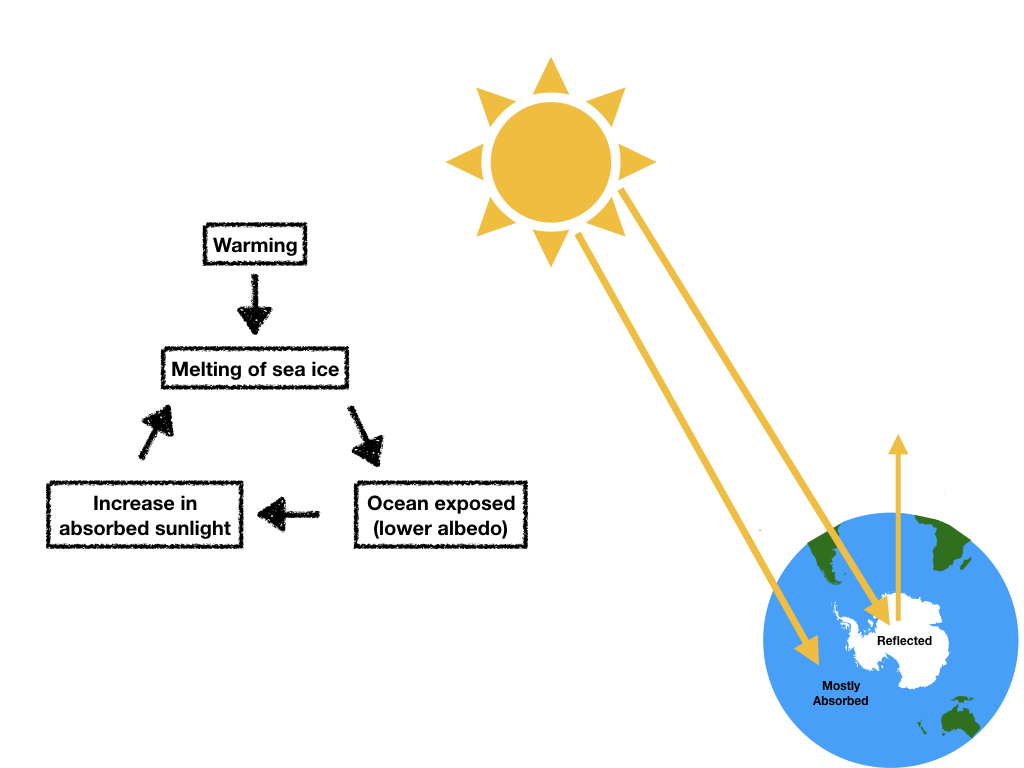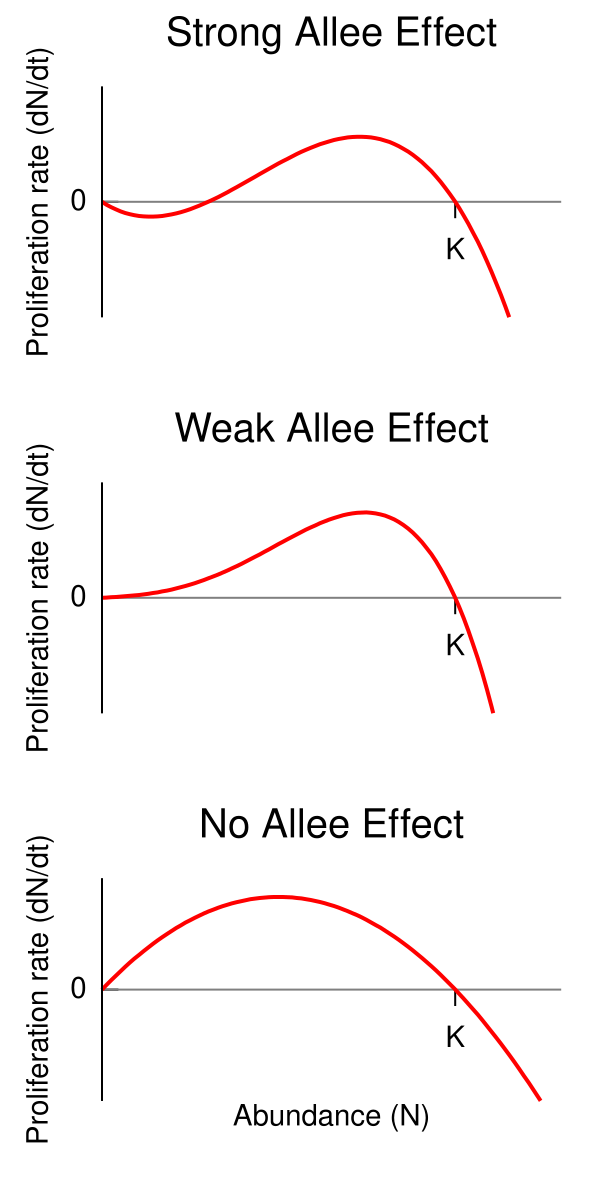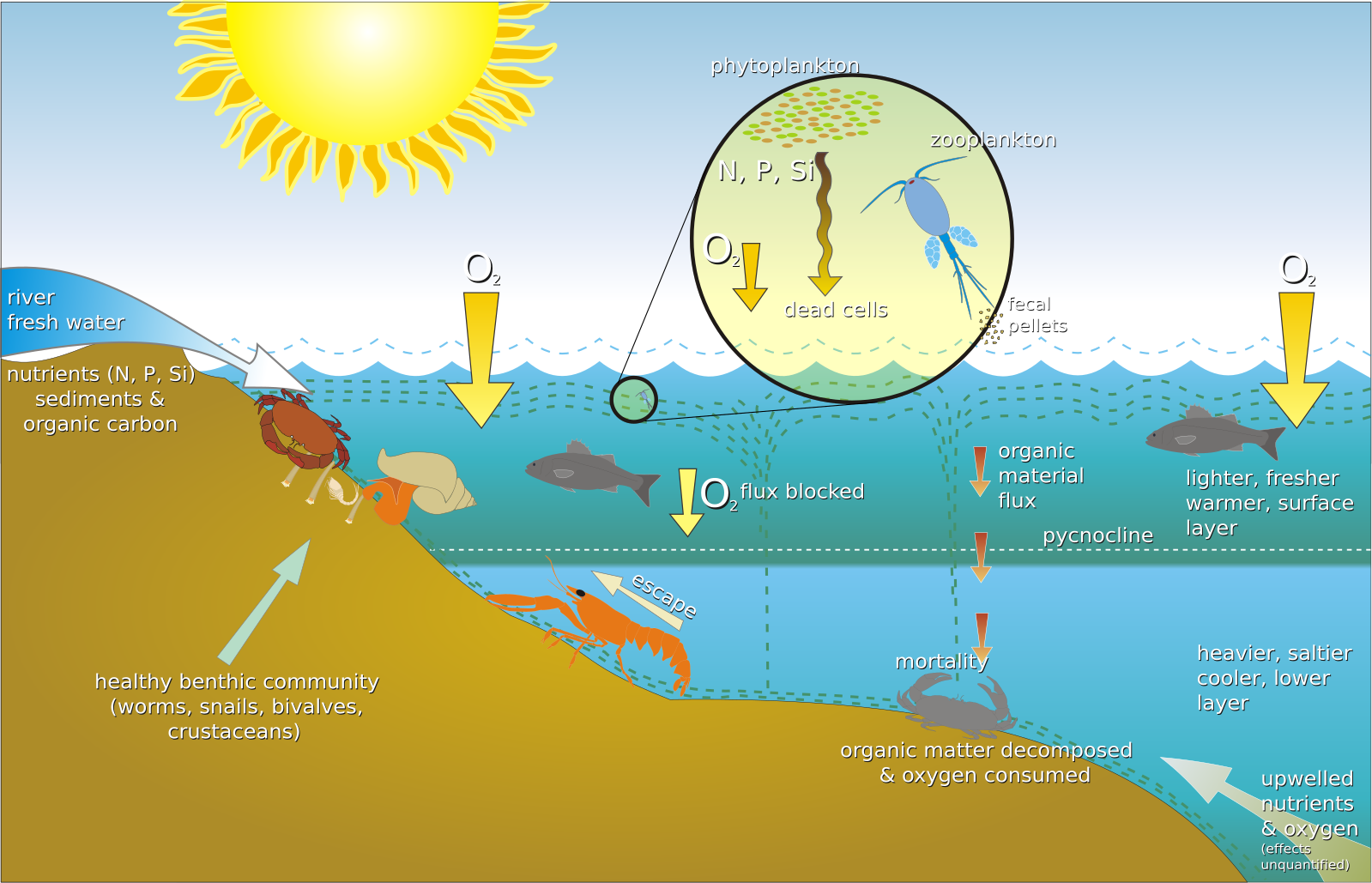IB Syllabus focus:
‘Positive feedback amplifies change, driving systems from equilibrium (e.g., ice–albedo warming, depensation). Amplification can push systems to tipping points and regime shifts, such as eutrophication.’
Positive feedback loops in environmental systems amplify initial changes, often destabilising equilibria. These processes can trigger tipping points, causing irreversible regime shifts in ecological and climatic systems.
Understanding Positive Feedback
Positive feedback occurs when a change in a system triggers processes that reinforce and increase the original change, pushing the system further away from equilibrium.
Positive Feedback: A process in which an initial change leads to further change in the same direction, amplifying the original disturbance.
Unlike negative feedback, which stabilises systems, positive feedback drives instability. The outcome can accelerate environmental change and lead to unexpected consequences.
Examples of Positive Feedback
Ice–Albedo Effect
Albedo refers to the reflectivity of a surface.
When ice melts, it reduces Earth’s reflective surfaces, exposing darker land or ocean that absorbs more heat.
Increased heat leads to further ice melt, reinforcing warming.
This creates a self-reinforcing cycle, making it a clear example of positive feedback in climate systems.

Diagram of the ice–albedo positive feedback showing how reduced sea-ice reflectivity increases absorbed solar energy, accelerating melt. The arrows depict the amplifying loop and its effect on temperature. The visual aligns with the text on positive feedback and tipping dynamics. Source
Depensation in Populations
Depensation describes a population decline that accelerates once numbers fall below a critical threshold.
For example, overfishing may reduce a fish stock so low that reproduction and recovery become impossible.
This decline spirals downward, showing how positive feedback can collapse populations.

Two stacked plots compare strong vs weak Allee effects, emphasising the threshold that can trigger rapid decline (depensation). This clarifies how positive feedback in populations creates tipping points. The lower panel (no Allee effect) is comparative context beyond the syllabus but helps contrast behaviours. Source
Tipping Points in Environmental Systems
Tipping points are thresholds where a small change can cause a disproportionately large and often irreversible system shift.
Tipping Point: A critical threshold at which a small disturbance pushes a system into a fundamentally different state.Tipping Point: A critical threshold at which a small disturbance pushes a system into a fundamentally different state.
Once crossed, tipping points make returning to the previous state difficult or impossible without significant intervention.
Features of Tipping Points
They often occur suddenly after long periods of apparent stability.
They are difficult to predict precisely.
They can result in permanent loss of ecosystem services.
Regime Shifts
Regime shifts occur when tipping points are exceeded, pushing systems into new, often less desirable, states.
Regime Shift: A large, abrupt, and persistent change in the structure and function of a system.
Examples include:
Eutrophication: Excess nutrient input into lakes causes algae blooms, oxygen depletion, and collapse of aquatic biodiversity.

Schematic of eutrophication, showing nutrient inputs, algal bloom, oxygen depletion, and loss of aquatic life. The diagram highlights the reinforcing processes that can drive a lake toward a new, degraded regime. Minor extra details (specific nutrient sources) are included but remain within syllabus scope. Source.
Coral Reef Degradation: Rising temperatures and acidification may push reefs into permanent decline, dominated by algae rather than corals.
Links Between Positive Feedback and Tipping Points
Positive feedback loops are the mechanisms that drive systems toward tipping points.
Amplification increases stress on the system.
Once thresholds are crossed, the system enters a new equilibrium or deteriorates entirely.
Process Outline
Initial disturbance occurs (e.g., warming, overfishing, nutrient input).
Positive feedback amplifies the change.
System resilience declines.
A tipping point is crossed.
Regime shift results in a new state.
Implications for Environmental Systems
Climate Change
Positive feedbacks accelerate global warming beyond human control.
Ice–albedo feedback and methane release from thawing permafrost are major risks.
Biodiversity
Depensation and habitat fragmentation reduce species survival chances.
Once thresholds are crossed, ecosystems may not recover.
Human Systems
Agriculture, fisheries, and water supply can all be destabilised by feedback-driven tipping points.
This poses challenges for sustainability and environmental management.
System Equilibrium and Irreversibility
Positive feedback leads to unstable equilibrium, where even small disturbances can escalate.
In contrast, negative feedback maintains stable equilibrium, encouraging recovery.
Irreversibility often results from loss of resilience, where systems cannot absorb further shocks.
Key Terms Recap
Positive Feedback: Amplifies change, destabilising systems.
Tipping Point: Critical threshold leading to a new state.
Regime Shift: Abrupt, persistent change in system function.
Depensation: Population collapse due to feedback-driven decline.
Ice–Albedo Effect: Climate feedback where melting ice reinforces warming.
FAQ
A positive feedback loop reaches a tipping point when the rate of change outpaces the system’s resilience.
Key factors include:
The magnitude of the initial disturbance.
The speed of feedback amplification.
System resilience (e.g., biodiversity, storage capacity).
External pressures such as human activity or climate change.
If resilience is low, even small changes can push the system beyond recovery.
In ecological systems, positive feedback often operates on shorter timescales, such as rapid eutrophication in lakes.
In climate systems, processes like the ice–albedo effect or methane release from permafrost occur over decades or centuries. However, once triggered, both can create long-lasting shifts.
The speed depends on the size and complexity of the system and the persistence of drivers.
Once a tipping point is crossed, the new system state may lack the conditions for recovery.
For example:
Nutrient-enriched lakes may continue cycling nutrients internally, even if external inputs are reduced.
Collapsed fish populations may lose genetic diversity, preventing recovery.
Reversibility is rare because stabilising processes are replaced by reinforcing ones.
Human actions frequently intensify natural feedback processes.
Examples include:
Deforestation reducing carbon storage, increasing atmospheric CO2, and enhancing warming.
Agricultural runoff accelerating eutrophication through nutrient inputs.
Overfishing driving populations below critical thresholds, triggering depensation.
These activities lower resilience and increase the chance of tipping points.
Yes, interacting loops can combine to accelerate instability.
For instance:
Arctic warming reduces ice cover (ice–albedo effect) and releases methane from thawing permafrost.
Both reinforce global temperature rise, increasing the likelihood of abrupt climate shifts.
Such interactions increase uncertainty and make predicting tipping points more complex.
Practice Questions
Question 1 (2 marks):
Define the term tipping point and explain why it is significant in environmental systems.
Mark Scheme:
1 mark for correct definition: tipping point as a critical threshold at which a small disturbance pushes a system into a fundamentally different state.
1 mark for significance: highlights that it can lead to irreversible change/regime shift in environmental systems.
Question 2 (5 marks):
Discuss how positive feedback processes can drive an ecosystem beyond its tipping point, using one named example.
Mark Scheme:
1 mark for describing positive feedback as a process that amplifies change and drives systems away from equilibrium.
1 mark for linking positive feedback to loss of stability/resilience in ecosystems.
1 mark for defining or describing tipping points as thresholds where small changes cause large system shifts.
1 mark for including a relevant named example (e.g., ice–albedo effect, eutrophication, depensation).
1 mark for explaining how the chosen example shows positive feedback leading to crossing of a tipping point/regime shift.

